Lancelot/Opdag Lancelot
Første afsnit tager dig på en guidet tur igennem Lancelot. Andet afsnit fokuserer på mere avancerede muligheder og begreber.
Generel information
Introduktion
Lancelot er en startmenu til KDE Software Compilation,
Lancelot eller Kickoff?
Lancelot har mange funktioner og indstillingesmuligheder, som Kickoff ikke har. Du kan finde en mere detaljeret sammenligning med andre programstartere her.
Kickoff er standard-startmenuen i KDE SC. For at erstatte Kickoff med Lancelot skal du tilføje den ved hjælp af panelet Tilføj widgets. Du finder mere information om, hvordan dette gøres på siden Plasma: Hvordan gør man.
Lancelot eller KRunner?
Lancelot kan bruges som en erstatning for KRunner. Se en liste med fordele på siden om sammenligning med andre programstartere.
Som standard kan Lancelot startes med tastaturgenvejen Alt + F5 (dette kan ændres).
Almindelig brug
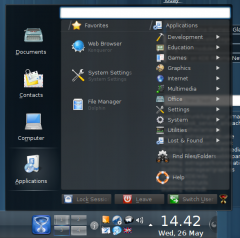 |
Lancelot med standardindstillinger |
Når du klikker på starterikonet, som du føjede til panelet, så åbnes Lancelots menu.
Det har fire afsnit - , , og .
Afsnit
Programmer
The Applications section contains a list of your favourite applications in the left column, and application categories in the right one. If the application that you are looking for is not in the list of Favourites, you can browse the categories on the right just by selecting one of them.
When you dive into the categories, the Favourites section will disappear to provide more space for the browsing. You can always return to it by using the breadcrumb bar on the top.
Computer
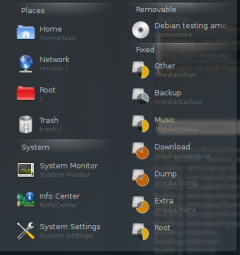 |
Computer section of Lancelot |
The Computer section contains list of defined places (as seen in Dolphin), some useful system applications and a list of storage devices.
You can eject/mount/unmount removable devices directly from the menu just by right-clicking the desired one and choosing the appropriate option from the context menu.
Contacts
The Contacts section shows the list of unread mails from Akonadi (KMail) and online contacts from Kopete.
Documents
The Documents section shows a list of office applications on the left, and a list of currently and recently opened documents on the right.
Searching capabilities
Lancelot provides all searching features KRunner has. You can use it to find applications, to do calculations, execute BASH commands, as a unit converter etc. For more details, see KRunner Usage.
If you don't like to use the mouse, every part of Lancelot can be accessed via keyboard.
| Action | Key | Description |
|---|---|---|
| Switch sections one by one | Page Up and Page Down | Shows previous and next section respectively |
| Switch to the specific section | Alt + number | Alt + 1 for Applications, Alt + 2 for Computer... |
| Activating items | Alt + letter | If an item has a letter underlined in its title, it can be activated by pressing together Alt and that letter |
| Moving through list items | Up and Down keys | |
| Moving between columns | Left and Right keys | |
| Activating the selected item | Enter | If no item is selected, the first search result is executed |
| Opening context menu for the selected item | Alt + Enter | |
| Search box completion | Tab and End; Left and Right keys | Tab and End keys use the whole suggestion while Left and Right move through the suggestion. |
More advanced topics
Advanced UI concepts
No-click activation
In order to reduce repetitive strain injuries produced by clicking the mouse buttons, Lancelot can be operated, if desired, without a single click.
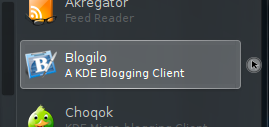
When you hover an item in the menu, a small icon that looks like a target with a mouse cursor drawn in it will appear. Instead of clicking, you can just hover the icon (or the area near it) and the item will be automatically activated.
Adaptive layout
The layout of the menu differs depending on the position of the applet which invoked it.
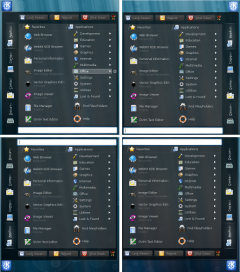
Always, the closest to the invoking applet (and the mouse cursor) are the section and system buttons, and the search box is on the opposite side since it has the focus by default and you don't need to click it in order to use it.
The sections are also reordered so that the Applications section is the closest to the mouse cursor.
Adaptive item sizes
The less items a list has, the larger the items and bigger the area for clicking.
When there are more items, Lancelot tries to show them all at once by reducing the size. If there are too many items to be shown all at once, the scrollbars are used as a solution.
Show sections inside the applet
If you think that the section buttons are too big and would be better if placed inside the panel itself, just right-click the applet, choose and .
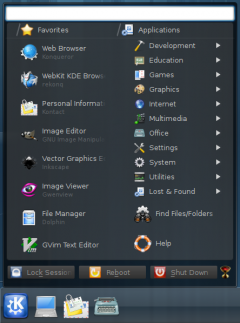
Show smaller section buttons
If you think that the section buttons are too big, but you don't want to place them inside the panel, just right-click them and choose .
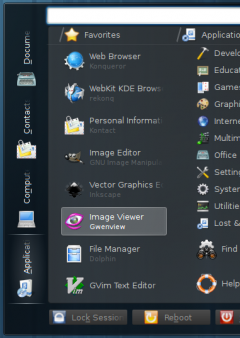
Custom system actions
If you don't use session switching (the 'switch user' feature), you can set different actions to the buttons in the bottom part of the window via the tab of the Lancelot's configuration dialogue.
Custom applications
You can choose which applications to show in the Documents and System sections via the tab of the Lancelot configuration dialogue.
Reordering items
You can change the order of favourite applications just by drag and drop. Mind that for it to work, you need to unlock your desktop first.
Some users prefer that the applications subcategories open in separate popups like they are used to from the classic menu from KDE 3. Since KDE SC 4.5, a new experimental feature was added to Lancelot which enables this behaviour.
To enable it, check the option in the tab of Lancelot's configuration dialogue.
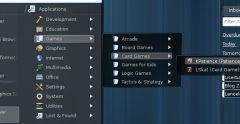
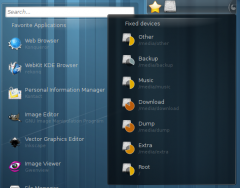
It is useful to have things that you use often placed on the desktop or the panel. For more info, see using the Shelf applet
